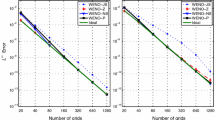Abstract
The weighted essentially non-oscillatory (WENO) methods are a popular high-order spatial discretization for hyperbolic partial differential equations. Recently Henrick et al. (J. Comput. Phys. 207:542–567, 2005) noted that the fifth-order WENO method by Jiang and Shu (J. Comput. Phys. 126:202–228, 1996) is only third-order accurate near critical points of the smooth regions in general. Using a simple mapping function to the original weights in Jiang and Shu (J. Comput. Phys. 126:202–228, 1996), Henrick et al. developed a mapped WENO method to achieve the optimal order of accuracy near critical points. In this paper we study the mapped WENO scheme and find that, when it is used for solving the problems with discontinuities, the mapping function in Henrick et al. (J. Comput. Phys. 207:542–567, 2005) may amplify the effect from the non-smooth stencils and thus cause a potential loss of accuracy near discontinuities. This effect may be difficult to be observed for the fifth-order WENO method unless a long time simulation is desired. However, if the mapping function is applied to seventh-order WENO methods (Balsara and Shu in J. Comput. Phys. 160:405–452, 2000), the error can increase much faster so that it can be observed with a moderate output time. In this paper a new mapping function is proposed to overcome this potential loss of accuracy.
Similar content being viewed by others
References
Aràndiga, F., Baeza, A., Belda, A.M., Mulet, P.: Analysis of WENO schemes for full and global accuracy. SIAM J. Numer. Anal. 49, 893–915 (2011)
Balsara, D.S., Shu, C.-W.: Monotonicity preserving weighted essentially non-oscillatory schemes with increasingly high order of accuracy. J. Comput. Phys. 160, 405–452 (2000)
Borges, R., Carmona, M., Costa, B., Don, W.S.: An improved weighted essentially non-oscillation scheme for hypebolic conservation laws. J. Comput. Phys. 227, 3191–3211 (2008)
Castro, M., Costa, B., Don, W.S.: High order weighted essentially non-oscillatory WENO-Z schemes for hyperbolic conservation laws. J. Comput. Phys. 230, 1766–1792 (2011)
Gottlieb, S., Shu, C.-W., Tadmor, E.: Strong stability-preserving time discretization methods. SIAM Rev. 43, 89–112 (2001)
Harten, A.: ENO schemes with subcell resolution. J. Comput. Phys. 83, 148–184 (1987)
Harten, A., Osher, S.: Uniformly high order essentially non-oscillatory schemes I. SIAM J. Numer. Anal. 24, 279–309 (1987)
Harten, A., Osher, S., Engquist, B., Chakravarthy, S.: Some results on uniformly high order accurate essentially non-oscillatory schemes. Appl. Numer. Math. 2, 347–377 (1986)
Harten, A., Engquist, B., Osher, S., Chakravarthy, S.: Uniformly high order essentially non-oscillatory schemes III. J. Comput. Phys. 71, 231–303 (1987)
Henrick, A.K., Aslam, T.D., Powers, J.M.: Mapped weighted essentially non-oscillatory schemes: achieving optimal order near critical points. J. Comput. Phys. 207, 542–567 (2005)
Jiang, G.-S., Shu, C.-W.: Efficient implementation of Weighted ENO schemes. J. Comput. Phys. 126, 202–228 (1996)
Lax, P.D.: Weak solutions of nonlinear hyperbolic equations and their numerical computation. Commun. Pure Appl. Math. 7, 159–193 (1954)
Liu, X.-D., Osher, S., Chan, T.: Weighted essentially non-oscillatory schemes. J. Comput. Phys. 115, 200–212 (1994)
Shu, C.-W.: Essentially non-oscillatory and weighted essentially non-oscillatory schemes for hyperbolic conservation laws. In: Advanced Numerical Approximation of Nonlinear Hyperbolic Equations. Lecture Notes in Mathematics, vol. 1697, pp. 325–432. Springer, Berlin (1998)
Shu, C.-W.: High order weighted essentially non-oscillatory schemes for convection dominated problems. SIAM Rev. 51, 82–126 (2009)
Shu, C.-W., Osher, S.: Efficient implementation of essentially non-oscillatory shock-capturing schemes. J. Comput. Phys. 77, 439–471 (1988)
Shu, C.-W., Osher, S.: Efficient implementation of essentially non-oscillatory shock-capturing schemes II. J. Comput. Phys. 83, 32–78 (1989)
Sod, G.A.: A survey of several finite difference metjods for systems of nonlinear hyperbolic conservation laws. J. Comput. Phys. 107, 1–31 (1978)
Woodward, P., Colella, P.: The numerical simulation of two-dimensional fluid flow with strong shocks. J. Comput. Phys. 54, 115–173 (1984)
Author information
Authors and Affiliations
Corresponding author
Additional information
The work of H. Feng and R. Wang was par tially supported by National Natural Science Foundation of China (No. 10971159) and NCET of China (No. NCET-06-0614).
Rights and permissions
About this article
Cite this article
Feng, H., Hu, F. & Wang, R. A New Mapped Weighted Essentially Non-oscillatory Scheme. J Sci Comput 51, 449–473 (2012). https://doi.org/10.1007/s10915-011-9518-y
Received:
Revised:
Accepted:
Published:
Issue Date:
DOI: https://doi.org/10.1007/s10915-011-9518-y




